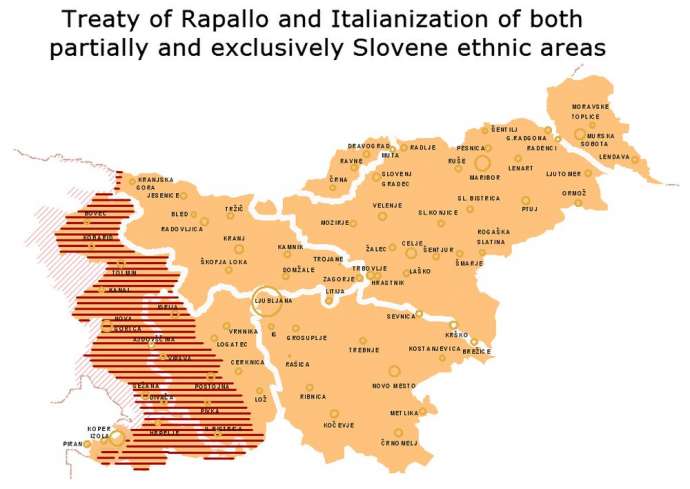In 1920 the Rapallo Treaty was signed by the Kingdom of Serbs, Croats and Slovenes (Kingdom of SCS, in 1929 renamed the Kingdom of Yugoslavia) and the Kingdom of Italy in Rapallo. The treaty defined a border between the two countries, assigning one third of the Slovene ethnic territory, Istria and part of Dalmatia, to Italy, which in turn recognized the Kingdom of SCS.
Along the Rapallo border, the Slovenian population of the former Austro-Hungarian Empire was divided into two parts. Slovenes who lived in Gorizia, part of Inner Carniola, Trieste, Istria and the Littoral were soon to experience the pressure of increasing fascism.
Italy entered WWI due to an alliance with Germany and Austro-Hungary that it had been part of since 1882. At the start of hostilities it refused to commit troops, claiming that the alliance was defensive in nature and that Austro-Hungary was the aggressor.
In 1915 Italy changed sides after the Triple Entente (France, Russia and Great Britain) promised it parts of the Austro-Hungarian territories under the secrecy of the so-called London Agreement (Italian: Patto di Londra), signed on April 26, 1915 by the representatives of Italy, the United Kingdom, France and Russia.
Italy pledged to declare war on the Central Powers, which it did less than a month later, on May 23, and was in return promised the following territories in case of the Entente’s victory:
Trst (Trieste), Trento, Gorica, Istria, Protectorate over Albania, the port of Vlorë, Dodecanese Islands, Zadar, parts of Dalmatia, the Soča River Valley and Southern Tyrol.
The agreement became public with the fall of Tsarist Russia, when Vladimir Lenin, a fierce opponent of war and secret diplomacy, in 1917 publically declared that the new Soviet state no longer recognized the Agreement.
In a new international situation that followed with the war’s end in 1918 the United States became involved as well. President Woodrow Wilson rejected Italian claims for Dalmatia, but agreed that the Slovenian Littoral and much of Istria, including Pula, belong to Italy.
Backed with such an international support Italy headed to Rapallo in 1920, where it was to sign a peace deal with a newly established, not yet recognised state.
About one-third of the Slovene ethnic territory remained outside the country of origin, all of Istria, Rijeka and Zadar with their immediate hinterland. The aforementioned territories immediately received a strong wave of violent Italianization through fascist attacks, arson, imprisonment, torture, internment and killing of Slovenes and Croats. Tens of thousands were expelled to southern Italy, and more than one hundred thousand were forced to flee to Yugoslavia and other countries.






